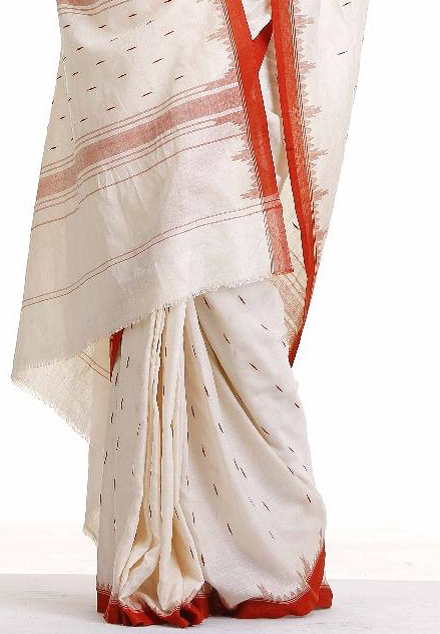Kotapad Saree
Background
Coarse cotton fabrics dyed with natural dye ‘Aal’ (Morindacytrofolia) of Kotpad village of Koraput District in southern Odisha situated about 70 km away from Koraput has a significant taste in use and attract consumers both in the country and abroad. The magic touch of the tribal weavers (Mirgana caste) of this village has occupied a prominent place in the map of Indian Handloom Industry. The village is surrounded by the dense forest of Malkangiri and Umerkote area of the district. Due to favourable climatic condition, Aal trees grow abundantly in these forests which are not found in any forest of the country. These Aul trees are nature’s gift for the tribal weavers of this area. These trees play a vital role for manufacturing of such dyed fabric by the tribals.

Material used
Coarse hand spun or mill spun cotton yarn upto 20s count and natural dye material “Aal” which is applied on cotton yarns using castor oil, cow dung, alkaline solution from ash and ferrous sulphate. Now a days, doubled cotton yarns of finer counts are also being used.
Technique applied
Weaving is done on a pit loom which is the most primitive in this modern age. Mostly 3 throw shuttles are used to develop a solid border temple design locally called “Phoda Kumbha”. Extra weft yarn wound on “Nan” is used to develop typical tribal motifs like fish, conch, crab, butterfly, pigeon, duck, snake, pot, axe, boat, hand fan, temple palanquin etc. Motifs are developed manually without the help of extra attachment like dobby/Jacquard/Jala.
How to distinguish genuine Kotapad Saree
- Generally, yarn dyed coarse cotton fabric in Indian red or reddish black colour used for dress material. However, presently, finer variety of same character is woven as saree.
- Extra weft typical tribal designs like fish, conch, crab, butterfly, pigeon, duck, snake, axe, pot, boat, hand fan, temple palanquin etc are woven with thick cotton yarn.
- Contrast solid colour border is woven with three shuttles.
- Placing or arrangements of extra weft designs are not generally uniform, since these are not woven with the help of any design devices.
Source : Kotapad Saree
Last Modified : 9/5/2023
